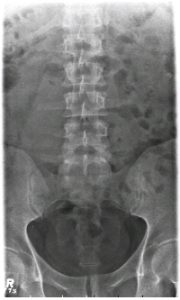Taking the Fear out of Movement
Choose Your Words Carefully
I had a patient come in recently to their physical therapy session and tell me that another medical professional told her that she had “the worst, most degenerative” lumbar spine he had ever seen after looking at her x-ray. She was devastated hearing that news. She was not even having pain in her low back at the time. She was doing a normal post-operative visit after undergoing a hip surgery and getting an x-ray of her pelvis 3 months after. She came into PT wondering if she needed to start treating her back and was worried that she would never be able to be active again because she did not want to make her back any worse.  She left her previous physical therapy appointment in great spirits, with confidence in the way she was moving, and feeling good about all of the functional abilities she had re-gained such as getting back into an exercise routine, returning to work, and lifting her grandchild without pain. After hearing those damaging words about her x-ray, she entered her PT session defeated and fearful of movement even though she had had no increase in her pain levels. She was just told information about her low back that was unnecessary and harmful.
She left her previous physical therapy appointment in great spirits, with confidence in the way she was moving, and feeling good about all of the functional abilities she had re-gained such as getting back into an exercise routine, returning to work, and lifting her grandchild without pain. After hearing those damaging words about her x-ray, she entered her PT session defeated and fearful of movement even though she had had no increase in her pain levels. She was just told information about her low back that was unnecessary and harmful.
As a physical therapist, one of my primary duties is to educate people about their pain and do it with the most current and scientific research in mind. Often times the fear that healthcare providers instill in patients by saying “it’s the worst knee degeneration I have ever seen” or “your low back looks like you are 100 years old from your MRI results” or “your pelvis is out of alignment and I need to manipulate it to make the pain go away” leads to patients limiting how much they move. We can end up giving people more problems than what they actually have, change their perception on what they can or cannot do, and overall interfere with their quality of life. And then, crazy enough, their pain can actually get worse from these threatening words. Here is a link to a study performed on the impact words that healthcare providers use can have on people with low back pain.
http://www.annfammed.org/content/11/6/527.long
Furthermore, here is a great link to research that displays how there is not always consistency with MRI and x-ray findings and pain location and/or presence.
https://coloradoinmotion.com/wp-content/uploads/2014/05/VOMIT-Poster-2014-SAMPLE.jpg
Our pain is produced by the brain as a protective mechanism in response to information that it is receiving from neural channels all over our body that are connected to every system in our body (musculoskeletal, integumentary, immune/endrocrine to name a few). Our brain is there to relay that information onto us, especially if something could be harming or potentially harmful to the body.
At Omaha Physical Therapy Institute, the physical therapists focus is on teaching people about why they feel pain and what they can do to decrease the threat level to the central nervous system through strategies to improve our feeling of “safety.” Moving through comfortable, non-threatening ways can help with decreasing the intensity and frequency of pain and can give patients a sense of “ability” despite the discomfort that they have been feeling. This confidence in movement will lead to more movement and typically less pain.
Take home point: So, when speaking with a patient, it is better to NOT be dramatic about anatomical issues as they may not even be the source of threat anyway. Calming, gentle words and movements as well as education can decrease fear, increase movement, and create a greater potential for improved comfort with function. Move and improve!
Katie Cordery, PT
Omaha Physical Therapy Institute (OPTI) is an outpatient orthopedic and sports physical therapy clinic with it’s main location at 144th & Dodge and it’s Athlete’s In Motion (A.I.M.) Clinic located at 144th & Giles. The physical therapists at OPTI have a passion for learning and stay up to date on the most current pain neuroscience. This has allowed for more efficient and effective care as our treatments always include educating our patients about their pain with strategies to address it at the time of treatment as well as in the future.
Darlo B, Dowell A, Baxter GD, Matheson F, Perry M, Dean S. The Enduring Impact of What Clinicians Say to People With Low Back Pain. Ann Fam Med. 2013;527-534.
